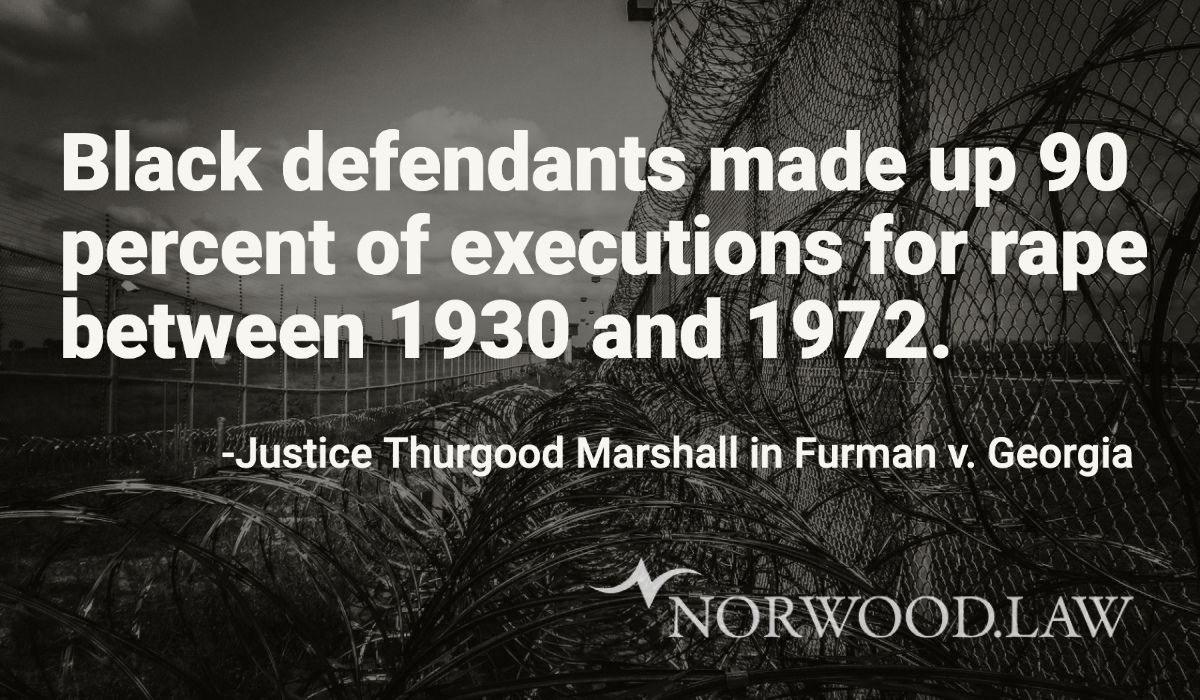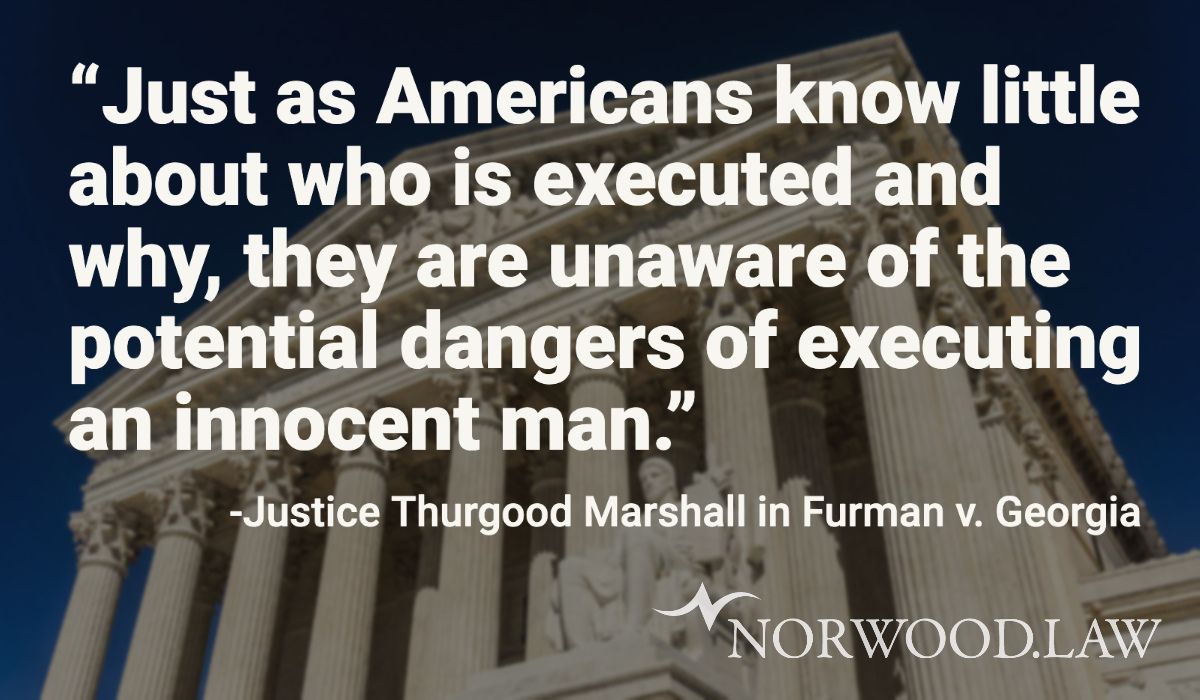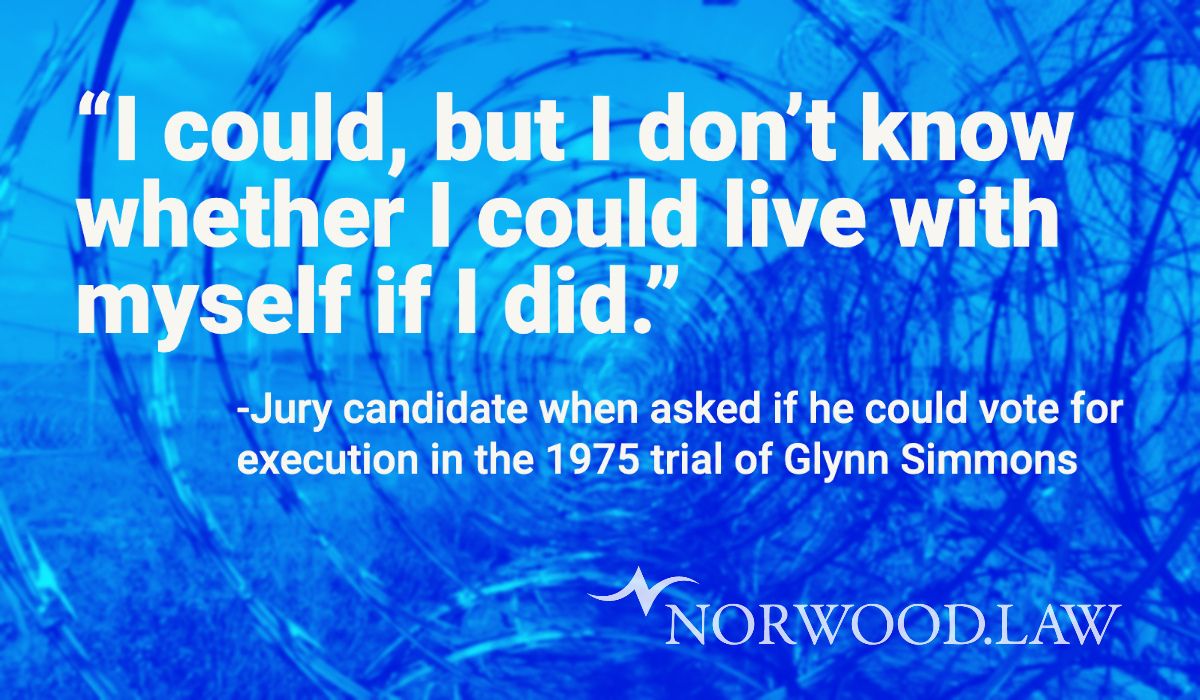By G.W. Schulz
Glynn Ray Simmons has the U.S. Supreme Court to thank for his life. If not for a series of watershed rulings from the high court during the 1970s, Simmons would have been executed decades ago in Oklahoma. With time, hope, and help from Norwood.Law since then, Simmons was finally granted a new trial in July of 2023 giving him another chance to prove to a fresh jury that he is innocent of murder.
Simmons has endured 48 years of being locked up, some of which was spent on Oklahoma’s notorious death row. He only narrowly escaped execution owing to a heated national debate at the time of his 1975 conviction over whether the death penalty was constitutional.
The Supreme Court fueled the fire with a landmark 1972 decision known as Furman v. Georgia that halted some 600 then-pending executions. Additional rulings followed, and together they created upheaval for the more than 40 states like Oklahoma at the time that authorized capital punishment. Another decision four years after Furman resulted in the death sentences of Simmons and others being blocked. His sentence was amended to life in prison.
Strident debate over the death penalty continues today in America and many still ask whether we can ever be certain enough about a person’s guilt to terminate a life. Oklahoma has long been among the most vocal supporters of the death penalty, and the state now executes more people per capita than any other. A dozen-and-a-half states have ended their use of the death penalty since the 1970s.
Fast-forward to today when Glynn Simmons began corresponding with Norwood.Law from behind bars after learning about our high-profile work on behalf of another man. That client, Corey Atchison, was let go in 2019 after spending 28 years in prison. A Tulsa County district judge ruled that Atchison was “actually innocent” and that his treatment had been a “fundamental miscarriage of justice.”
Norwood.Law decided to take up the case of Glynn Simmons in 2019 the year Atchison was released. Now with us in his corner, Simmons has a shot at proving he didn’t commit a 1974 killing that took place during a liquor-store robbery in the Oklahoma City suburb of Edmond. Until this moment, he’s endured decades of rejection from the Oklahoma Court of Criminal Appeals and the Oklahoma Pardon and Parole Board.
If Simmons prevails at his new trial, he becomes eligible to enter the National Registry of Exonerations as the longest-serving wrongfully convicted man in recorded U.S. history.
Before that was even a possibility, however, Simmons had to first contend with the fact that he’d been sentenced to die following his 1975 conviction. How could he fight for his freedom if he was put to death? Read on below to learn the full story.
If you’ve been accused of a crime, don’t wait to recruit the most passionate advocates in Oklahoma at Norwood.Law to tell your side of the story. And it’s not just criminal law we practice. If you find yourself ensnared in a family, business, or personal-injury dispute, Norwood.Law will bring the same commitment and skill to your corner that we have to the case of Glynn Simmons. When the time comes that you need our help, contact Norwood.Law for a free consultation at 918-582-6464.
A home invasion
The sequence of events that led to the Supreme Court’s 1972 Furman decision began on Aug. 11, 1967. That night, William Henry Furman broke into a Savannah, Georgia, home intending to burglarize it. Furman was 26 at the time and reportedly had a sixth-grade education.
The homeowner, William Micke, a father of five, woke up and confronted Furman. According to Furman’s version of events, his gun went off accidentally when he tripped, and he had not aimed the firearm with any intent to kill. “I didn’t know nothing about no murder until they arrested me,” Furman later said in court. “ … When the gun went off, I was down on the floor, and I got up and ran. That’s all.”
Either way, Furman was charged with murdering the homeowner. He was found guilty following a trial and sentenced on Sept. 20, 1968, to be executed. Attorneys for Furman first attempted to have the conviction and death sentence thrown out by the Supreme Court of Georgia.
When that failed, they took Furman’s case to the U.S. Supreme Court, which only accepts a small fraction of the cases brought to its doorstep each year. Furman’s attorneys argued that the death penalty as it was then practiced in the United States constituted “cruel and unusual punishment,” which was outlawed by the Eighth Amendment of the U.S. Constitution.
The Supreme Court agreed. But they did so in a highly complicated ruling with individual opinions written by the justices that left states confused about how to proceed with the death penalty. Furman did not outlaw executions, but it did make clear that death-penalty statutes would have to be reformed.
Upheaval from Furman
The ruling handed down from the justices on June 29, 1972, sent shockwaves across the legal community and state legislatures. In a decision with a razor-thin margin of 5-4, the justices in the majority ruled that the death penalty as it was then being practiced was unconstitutional. They argued that death sentences were being applied arbitrarily and randomly in the same way that people were struck by lightning.
Some observers thought the Furman decision would do away with the death penalty entirely. But the court stopped short of ending the practice of executions for good. It did, however, condemn death-penalty laws in states like Georgia and Oklahoma as discriminatory, arbitrary, and “capricious.” Judges and juries held the discretion to decide who was sentenced to death. From one case to the next, determining who would be executed often depended on shifting moods and attitudes.
Justice Potter Stewart, who voted with the majority, pointed out that the death penalty was “unique in its total irrevocability. … It is unique in its absolute renunciation of all that is embodied in our concept of humanity.” Death-penalty defendants were a “capriciously selected random handful upon whom the sentence of death has been imposed.” The then-current system, Stewart concluded, allowed death sentences to be “wantonly” and “freakishly” applied.
Justice William Douglas added that the “uncontrolled discretion” of judges and juries “enables the [death] penalty to be selectively applied, feeding prejudices against the accused if he is poor and despised and lacking political clout, or if he is a member of a suspect or unpopular minority.”
Furman is a black man. People of color were then and are now unequally treated across the criminal-justice system and in capital-punishment sentencing. Prior to Furman, all-white juries had the full discretion to discriminate based on race. In two cases where the facts were largely the same, jurors and judges could sentence someone who is black to die while a white person was sent to prison.
The legendary Supreme Court Justice Thurgood Marshall along with Justice William Brennan in their Furman opinions argued against the death penalty outright. In their interpretation, executions completely violated the Constitution’s ban on cruel and unusual punishment. Justice Marshall argued that capital trials were too vulnerable to lying from witnesses or mistaken eyewitness testimony or flawed forensic evidence.
Marshall pointed to statistics showing that more than half of the roughly 3,900 executions that took place between 1930 and the Furman decision in 1972 involved black defendants, a number massively disproportionate to the general black population in the United States. Black defendants made up a stunning 90 percent of executions for rape during that time. The Supreme Court would later entirely forbid using the death penalty in rape cases. Wrote Marshall about the execution statistics:
“Just as Americans know little about who is executed and why, they are unaware of the potential dangers of executing an innocent man. Our ‘beyond a reasonable doubt’ burden of proof in criminal cases is intended to protect the innocent, but we know it is not fool-proof. … Proving one’s innocence after a jury finding of guilt is almost impossible. … We have no way of judging how many innocent persons have been executed, but we can be certain that there were some.”
The four justices in the minority who voted to uphold Furman’s sentence, meanwhile, were all nominees of Republican presidents. They wrote that the Constitution simply did not prohibit capital punishment.
That conclusion would be reached in another case four years later. In Gregg v. Georgia, the justices found that while the manner in which the death penalty was applied by states could become unconstitutional, sentencing defendants to die was not on its face cruel and unusual. That is why despite the Furman ruling, we continue to have executions in America today.
Oklahoma responds to Furman
While Furman did not end capital punishment in the United States, it did instantly lead to a de facto moratorium on the hundreds of executions that were pending at the time. The ruling left states in the lurch as they scrambled to overhaul their existing frameworks for the death penalty.
This included Oklahoma, which sought to reform its murder statutes through the prism of the dizzying number of individual opinions published by the Supreme Court justices in Furman.
Legislative responses to Furman around the nation typically fell into two categories, according to a Tulsa Law Journal article from 1988. One involved imposing guidelines on judges and juries in which they would rely on specific aggravating and mitigating circumstances to determine whether someone was to be executed.
The second category was more aggressive: Oklahoma and other states like Louisiana and North Carolina decided to mandate the death penalty in all cases where defendants were convicted of certain crimes like first-degree murder. Judges and juries no longer had any say in the matter. The Tulsa Law Journal wrote that the plan was to fully eliminate arbitrariness in the death penalty by eliminating the discretion of judges and juries altogether.
Since first-degree murder was the charge given to Glynn Simmons and his co-defendant, Don Roberts, that meant they were automatically sentenced to die upon their convictions. Prior to their trial commencing in June of 1975, numerous potential jurors were ejected, because they expressed an unwillingness to convict if it meant mandatory death sentences for the two men.
As jury selection got underway, according to the trial transcript, Oklahoma County District Judge Joe Cannon explained to the room of potential jurors that the state of Oklahoma imposed an automatic sentence of death in first-degree murder cases.
Then he began to screen the prospective jurors by questioning them individually about their views on capital punishment. After swearing to answer questions from the judge truthfully, each possible juror was asked: “Could you, without doing violence to your conscience, agree to a verdict imposing the death penalty?”
Most said they could. Others hesitated, and that was enough for them to be denied from serving on the jury. As the majority justices pointed out in Furman, those who opposed the death penalty had been historically less able to influence the outcomes of capital cases, because they’d been barred from participation due to their views.
For prospective jurors in the Simmons case who were unsure about how they felt, an unwavering Judge Cannon reiterated to them that mandatory executions were the law of the land. The jury only determined guilt or innocence, not sentencing.
“You have got a right to not like the law,” Judge Cannon told them, “you have a right to want to change it, and you can go to the legislature or call one of your legislators and ask them to change the law. But if you sit on the jury, we have to try the case under the same law.”
Prospective juror Darrell McGehee of Del City, Oklahoma, said he didn’t know if he could vote guilty. Judge Cannon asked him: Would your conscience, or feelings, or religion bar you from voting guilty if you knew the outcome was execution? Could you vote guilty if the evidence supported it?
“I could,” McGehee responded, “but I don’t know whether I could live with myself if I did.” McGehee had no problem convicting Simmons and his co-defendant of murder, he said. But he did have a problem with automatic execution.
McGehee was let go.
Another prospective juror, Leola Mathues of Oklahoma City, said she believed in punishing criminals but that extinguishing a life was too extreme. She, too, was ejected. Another would-be juror said he unequivocally could not vote guilty if it meant death and was summarily dismissed.
Once the final, all-white jury of 12 was empanelled, Simmons and Roberts, who are black, were convicted of first-degree murder and automatically sentenced to die. Their trial lasted three days.
Mandatory killings are banned
Despite changes made by the states to their murder statutes following Furman v. Georgia, dispute nationwide over capital punishment was far from finished. One year after Simmons and Roberts were convicted, the death penalty once again landed on the steps of the U.S. Supreme Court.
The justices made fresh determinations across five new rulings. Found to be constitutional were newly passed murder statutes that didn’t mandate executions for certain crimes. Those states had applied ground rules to judges and juries for sentencing, such as determining whether there were aggravating circumstances, in which an offender’s acts were particularly heinous, atrocious, or cruel.
But the decisions handed down in Woodson v. North Carolina and Roberts v. Louisiana were aimed squarely at states like Oklahoma. Deemed unconstitutional were state statutes that did not observe ground rules but instead imposed mandatory death sentences that were beyond the discretionary reach of judges and juries.
In rulings that like Furman were decided narrowly with 5-4 votes, the justices in the majority found that it was cruel and unusual punishment and thus a violation of the Eighth Amendment to subject every person convicted of certain offenses to death. For the majority, mandatory executions were as unconstitutional and extreme as giving judges and juries too much freedom to decide when someone was executed.
Wrote the majority in Woodson v. North Carolina:
“The North Carolina statute impermissibly treats all persons convicted of a designated offense not as uniquely individual human beings, but as members of a faceless, undifferentiated mass to be subjected to the blind infliction of the death penalty.”
Oklahoma lawmakers and politicians reacted to the latest rulings in a panic. In July of 1976, the same month that the Supreme Court handed down its new rulings, former Democratic Oklahoma Gov. David Boren urgently called for a special legislative session to yet again draft new murder statutes. The regular session was six months away.
“I believe very firmly … the death penalty does serve as a deterrent to crime … We simply cannot go six months without a death-penalty statute, in my opinion,” Boren said at the time, according to the Southwest Ledger in Lawton, Oklahoma. Mandatory executions were scrapped. Lawmakers in their place penned new rules that more closely mirrored the “guided discretion” being given to judges and juries in other states.
After mandatory executions were declared unconstitutional, our client Glynn Simmons and his co-defendant, Don Roberts, challenged their own death sentences before the Oklahoma Court of Criminal Appeals in 1977. Their sentences were amended at that time to life in prison.
Representing Glynn Simmons
After deciding in 2019 to begin advocating on behalf of Simmons, Norwood.Law set about investigating a half-century of police reports, legal briefs, testimony, attempted appeals, and court transcripts.
Then in a new, exhaustive application to the Oklahoma County District Court in Oklahoma City, we argued that Simmons was not involved in a 1974 liquor-store robbery, during which a clerk was murdered. A customer was also shot in the head but survived. The wounded customer became the sole witness in a case that had no physical evidence at all – no fingerprints, no surveillance video, no DNA, no gun.
Before choosing to grant Simmons a new trial, District Judge Amy Palumbo had to consider arguments, testimony, and evidence in the case, some of which had not been available to Simmons at his original trial in 1975. Local prosecutors who are our counterparts in the case had to admit in the spring of 2023 that Simmons was denied a fair trial when key documents about police lineups and the sole witness were withheld from him for 20 years.
Prosecutors were willing to accept a new trial. But we had hoped for several reasons that Judge Palumbo would fully exonerate Simmons without the need for a new trial.
One reason, for example, was that earlier prosecutors at Simmons’s 1975 trial in Oklahoma City had built their case almost entirely around one eyewitness. By her own admission, the witness had glimpsed at the perpetrators for just a few seconds inside the liquor store.
Another reason was that we had recruited a PhD psychologist, Dr. Curt Carlson of Texas A&M University, to examine the reliability of the eyewitness in-depth. In a report for us, Dr. Carlson cited dozens of research studies conducted since the 1970s that challenged the overreliance on eyewitness testimony in criminal prosecutions and pointed to the natural frailty of human memory.
Furthermore, two prosecutors responsible for sending Simmons to death row later admitted to misgivings about the case. One confessed to being “troubled” for years by weaknesses in the thinly presented evidence. Another conceded that prosecutors had relied heavily on eyewitness testimony, “and we now know that’s not always best.” Also, a juror who voted to convict Simmons and Roberts at the 1975 trial, as well as a sister of the clerk who was killed in the liquor store, later confessed to having doubts about their guilt.
But despite escaping the executioner’s axe with intervention from the U.S. Supreme Court, Glynn Simmons and co-defendant Don Roberts were given life sentences for a crime the two men still insist they didn’t commit. In fact, the men say they hardly knew one another at the time of their arrests, having met only briefly at a party after the robbery occurred.
Roberts said he’d been in Dallas at the time of the robbery. He was paroled in 2008 after serving 33 years. Simmons wasn’t so lucky. That’s even though several people have testified or said in sworn statements that Simmons was in Harvey, Louisiana, celebrating the holidays on Dec. 30, 1974, when the liquor-store robbery and murder took place. Simmons had only trekked to Oklahoma City later in 1975 to pursue work opportunities and stay with family.
If indeed law enforcement in Oklahoma City had the wrong men all along, who actually committed the crime remains a mystery.



